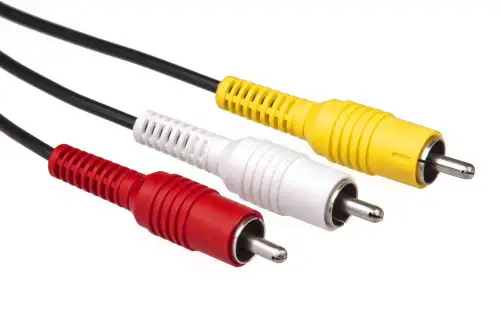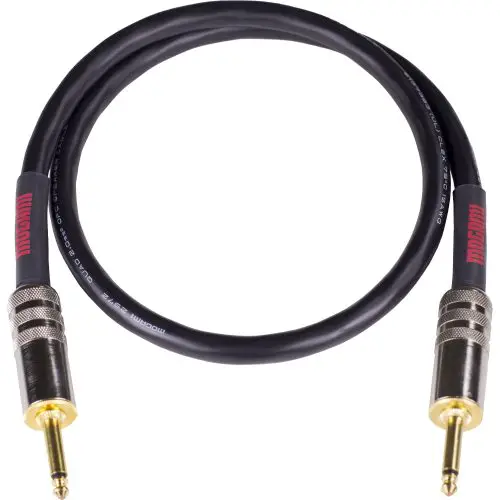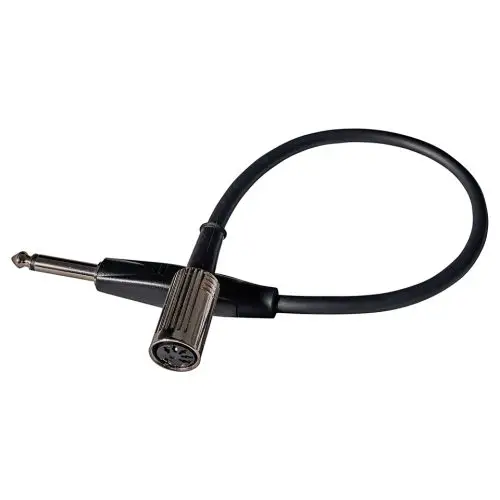Can You Use Any Cable for an Electric Guitar?
You cannot just use any cable for an electric guitar. Electric guitars require specific cables that are designed to handle the unique needs of the instrument. Using the wrong cable can result in poor sound quality, interference, nd even damage to your equipment.
Electric guitar cables are designed to carry the high impedance signal produced by the guitar’s pickups. These cables are often shielded to reduce unwanted noise and interference. They also have a high-quality, durable construction to withstand the rigors of regular use.
Using a cable that is not specifically designed for electric guitars can lead to several issues. Firstly, you may experience signal loss or degradation, which can result in a weaker, less defined tone. The wrong cable may not be able to handle the high impedance signal properly, resulting in a loss of clarity and depth in your sound.
Additionally, using a non-shielded cable can introduce unwanted noise and interference into your signal. This can be particularly problematic if you are playing in a live setting or recording in a studio where a clean, noise-free signal is crucial.
Furthermore, using the wrong cable can also put your equipment at risk. Electric guitars typically have a 1/4-inch jack, while other audio devices may have different types of connectors. Using an adapter or a cable that doesn’t properly fit can cause stress on the guitar’s input jack, potentially leading to damage or even a complete failure.
As a guitarist myself, I have experienced the difference that using the right cable can make. When I first started playing, I used a cheap, generic cable that was lying around. I quickly realized that my sound was lacking clarity and definition.
After upgrading to a high-quality, shielded cable designed for electric guitars, I noticed a significant improvement in my tone. The signal was cleaner, and the unwanted noise was greatly reduced.
I have also witnessed the consequences of using the wrong cable. A friend of mine used a cable with a different connector than his guitar’s input jack, and it caused his guitar’s jack to become loose and eventually stop working altogether. It was an expensive lesson for him, and he now understands the importance of using the correct cable.
So, if you want to get the best out of your electric guitar and protect your equipment, invest in a quality cable that is specifically designed for electric guitars. Your sound will thank you.
Here’s a summary that sums up the entire article if you are too busy. Otherwise, read till the end because there are much more to the topic!
| Topic | Summary |
|---|---|
| Can You Use Any Cable for an Electric Guitar? | No, electric guitars require specific cables designed to handle their high impedance signal. Using the wrong cable can result in poor sound quality, interference, and potential equipment damage. |
| Are all Guitar Cables Universal? | No, not all guitar cables are universal. Different types of cables serve different purposes and have unique characteristics. It’s important to choose the right cable based on your specific needs and equipment requirements. |
| Do Cheap Guitar Cables Affect Tone? | Yes, cheap guitar cables can affect tone. Poor construction, inadequate shielding, and subpar components can result in signal degradation, loss of clarity, and increased interference. |
| Can I Use a Microphone Cable as a Guitar Cable? | No, using a microphone cable as a guitar cable is not recommended due to impedance mismatch and potential signal loss. It is best to use a dedicated guitar cable for optimal performance. |
| What is the Difference Between a Balanced and Unbalanced Guitar Cable? | Unbalanced cables are common for guitars, while balanced cables are used in professional audio settings. Balanced cables cancel out interference, providing a cleaner and quieter signal, whereas unbalanced cables are more susceptible to interference. |
| How Long Can a Guitar Cable Be? | A high-quality guitar cable can be up to 25-30 feet long without significant signal degradation. Longer cables may result in slight loss of high-end clarity and increased susceptibility to interference. |
Are all guitar cables universal?

Not all cables are universal
Not all guitar cables are universal. Guitar cables come in various types and configurations, and their compatibility depends on the specific needs of your equipment. While certain cables may work with multiple devices, it is important to consider factors such as impedance, connectors, and shielding to ensure optimal performance.
Electric guitars typically use 1/4-inch mono cables, also known as instrument cables. These cables have a single plug on each end and are designed to carry the high impedance signal produced by the guitar’s pickups. They are not compatible with devices that require other types of connectors, such as XLR or RCA.
On the other hand, other audio devices such as mixers, amplifiers, and audio interfaces may require different types of cables. For example, XLR cables are commonly used for microphones and balanced audio connections.

RCA Cable
RCA cables are often used for consumer audio equipment, such as CD players or home theater systems. These cables are not interchangeable with instrument cables and may not provide the proper connections or signal integrity for your electric guitar.
It is also important to consider the length and quality of the cable. Longer cables can result in signal loss or degradation, so it is recommended to use the shortest cable necessary for your setup. Additionally, using low-quality or poorly shielded cables can introduce unwanted noise and interference into your signal, affecting your tone and overall sound quality.

Guitar cable
When choosing a guitar cable, it is best to opt for cables specifically designed for electric guitars. These cables are constructed to handle the unique needs of the instrument, with the appropriate connectors, impedance, shielding, and durability. While it may be tempting to use a cable that is lying around or readily available, investing in a high-quality guitar cable will ensure optimal performance and minimize potential issues.
In my experience, I have encountered situations where I needed to connect my electric guitar to different devices, such as mixers or audio interfaces. Using the wrong cable resulted in poor sound quality and issues with connectivity.
After learning about the importance of using the appropriate cable, I invested in cables designed specifically for my electric guitar. The difference was remarkable – the sound was cleaner, with less unwanted noise and interference.
I have also seen other guitarists struggle with using incompatible cables. At a gig, a fellow guitarist attempted to connect his electric guitar to a mixer using an XLR cable, which caused confusion and delays. It highlighted the importance of having the right cables for specific connections.
To ensure compatibility and optimal performance, it is always best to use cables designed for the specific needs of your equipment. This will help you achieve the best possible sound and avoid any unnecessary technical difficulties.
Also Read: Using Instrument Cables For Pedals: Are They Universal?
Do cheap guitar cables affect tone?
Cheap guitar cables can have indeed a noticeable effect on tone. While it is possible to find affordable cables that offer decent performance, extremely cheap cables often suffer from poor construction, inadequate shielding, and subpar components that can degrade the signal and impact the overall sound quality of your electric guitar.
Cheap cables can introduce additional resistance to the electrical signal passing through them. This added resistance can act as a filter, attenuating certain frequencies and causing a loss of clarity and definition in your tone. As a result, your guitar may sound duller, muddier, or lack the desired brightness and sparkle.
Inferior shielding is another common issue with cheap cables. Shielding is crucial to prevent unwanted interference and noise from entering the signal path.
Poorly shielded cables are more susceptible to electromagnetic interference, radio frequency interference, and even interference from nearby electrical sources such as fluorescent lights or computer monitors. These interferences can manifest as buzzes, hums, or static in your signal, affecting the overall quality of your tone.
Furthermore, the build quality of cheap cables may not hold up well to regular use and abuse. Thin cables, flimsy connectors, and weak solder points can lead to frequent failures, such as intermittent signals or complete signal loss. Not only can this be frustrating during rehearsals or performances, but it can also be costly as you may need to replace the cable more frequently
While there are affordable cables that offer decent performance, it is advisable to invest in a higher-quality cable specifically designed for electric guitars. A well-made cable with superior construction, shielding, and components can greatly enhance your tone and provide a reliable and consistent signal, ultimately elevating your playing experience.
Also Read: Is Expensive Guitar Easier To Play & Sound Nicer? (Vs Cheap)
Different Types of Guitar Cables: Explained
When it comes to guitar cables, there are several types to choose from depending on your specific needs: instrument cables, patch cables, speaker cables, and MIDI cables. Each type serves a different purpose and has unique characteristics that make them suitable for specific connections and equipment.

Instrument Cable
1. Instrument Cables: Instrument cables, also known as 1/4-inch mono cables, are the most commonly used cables for connecting an electric guitar or bass to an amplifier, pedalboard, or audio interface. These cables have a 1/4-inch plug on each end and are designed to carry the high impedance signal from your instrument’s pickups.

Patch cable
2. Patch Cables: Patch cables are shorter cables used to connect individual pedals on a pedalboard. These cables are typically available in a variety of lengths and are often used to preserve signal integrity and reduce cable clutter. Patch cables generally have a 1/4-inch plug on each end, but in some cases, they may use different connectors to accommodate specific pedalboard setups.

Speaker cable
3. Speaker Cables: Speaker cables are used to connect amplifiers to speaker cabinets. These cables are designed to carry a much higher powered signal than instrument cables, as they need to handle the current required to drive speakers. Speaker cables come in different gauges (thicknesses) to handle various power ratings and distances.

Midi cable
4. MIDI Cables: MIDI cables are used to transmit MIDI (Musical Instrument Digital Interface) data between synthesizers, keyboards, sequencers, and other MIDI-enabled devices. These cables typically have a DIN connector on each end and allow for the exchange of performance and control information between compatible devices.
When choosing guitar cables, it’s important to consider the type of connection you need to make and the specific requirements of your equipment. Using the correct type of cable for each connection will ensure optimal performance, signal integrity, and compatibility.
Can I use a microphone cable as a guitar cable?
You should not use a microphone cable as a guitar cable. While it may be tempting to use a microphone cable in a pinch, there are important differences between these two types of cables that make them unsuitable for interchangeable use.
Microphone cables are designed to carry the low impedance signal generated by microphones. They typically have XLR connectors on each end, which provide a balanced connection. On the other hand, guitar cables, also known as instrument cables, are built to handle the high impedance signal produced by electric guitars. They typically feature 1/4-inch mono plugs.
The main issue with using a microphone cable for a guitar is the impedance mismatch. Microphones require low impedance to work efficiently, while guitars produce a high impedance signal. Connecting a high impedance guitar output to a low impedance microphone input can result in a significant loss of signal strength and overall signal degradation. This can lead to a weaker, poorly defined tone, loss of dynamic range, and reduced clarity in your sound.
Moreover, microphone cables may not have the same shielding and construction quality as dedicated guitar cables. This lack of shielding can make the cable more susceptible to interference and noise, resulting in unwanted buzzes, hums, or static in your signal.
To ensure optimal performance and sound quality, it is highly recommended to use a proper instrument cable specifically designed for electric guitars. These cables have the impedance, shielding, and connectors necessary to handle the unique requirements of guitar signals, providing cleaner, more transparent, and reliable signal transmission.
How long should a guitar cable be?
The length of a guitar cable can vary depending on several factors, including the quality of the cable, the impedance of the guitar, and the desired signal quality:
In general, a high-quality guitar cable can be up to 25-30 feet (7.6-9 meters) long without significant signal loss or degradation. This length is suitable for most situations, including home practice, studio recording, and small to medium-sized live performances.
However, it’s important to note that as the cable length increases, the resistance and capacitance of the cable can start to affect the high frequencies of the guitar signal. This can result in a slight loss of high-end clarity and definition. Additionally, longer cables are more prone to picking up electrical interference, especially in environments with high levels of radio frequency interference (RFI) or electromagnetic interference (EMI).
If you need a longer cable for your specific setup, using a higher-quality cable with better shielding can help mitigate some of these issues. Additionally, using a buffer or a signal booster pedal can maintain the integrity of the signal over longer cable lengths.
For professional live performances, it’s common to use shorter guitar cables, typically in the range of 15-20 feet (4.5-6 meters) or even shorter. Shorter cables help reduce cable clutter on stage and minimize the chances of accidentally stepping on or tripping over a long cable.
Ultimately, the ideal cable length will depend on your specific needs and the environment in which you’ll be performing or recording. It’s always a good idea to test different cable lengths and assess the impact on your tone and signal quality to find the best balance between convenience, signal integrity, and sound quality.
What is the difference between a balanced and unbalanced guitar cable?
The main difference between a balanced and unbalanced guitar cable lies in how the cable handles potential interference:
Unbalanced guitar cables, also known as mono cables, are the most common type of guitar cables. They have two conductors: a center conductor that carries the audio signal and a surrounding shield that acts as a ground.
Unbalanced cables are susceptible to electrical interference, such as electromagnetic interference (EMI) and radio frequency interference (RFI). This can result in unwanted noise, hum, or buzzing in the signal, especially when used in environments with high electrical interference.
On the other hand, balanced guitar cables have an additional conductor, known as the ground or shield conductor. This creates a balanced audio connection that effectively cancels out interference. Balanced cables use XLR connectors and are commonly used in professional audio settings.
They are particularly useful for longer cable runs or in environments with high interference, such as recording studios or live sound setups.
The ground conductor in balanced cables helps eliminate noise by carrying an inverted copy of the audio signal. At the receiving end, the inverted signal is flipped back to its original polarity, effectively canceling out any noise picked up along the way. This differential signaling provides a cleaner and quieter signal transmission, resulting in improved sound quality and reduced interference.
While unbalanced cables are typically sufficient for most guitar applications, balanced cables can be beneficial in certain situations where interference is a concern. However, it’s important to note that not all guitars, amplifiers, or audio interfaces have balanced inputs or outputs. Therefore, it is essential to ensure compatibility between the equipment and the cable type.
In my experience, I primarily use unbalanced guitar cables for my regular guitar setups. They provide a reliable connection and satisfactory sound quality. However, when I find myself in environments with high levels of electrical interference, such as playing at large venues or near power sources, I switch to balanced cables. I have noticed a significant reduction in unwanted noise and interference, resulting in a cleaner and more professional sound.
It’s important to be aware of the types of inputs and outputs your equipment has and the corresponding cable requirements. Some high-end guitars, audio interfaces, or studio equipment may have balanced connections, in which case using a balanced cable can provide the best results.
Ultimately, understanding the differences between balanced and unbalanced guitar cables allows you to make informed decisions based on your specific needs and the environment in which you’ll be playing or recording. Choosing the right cable type can help ensure optimal sound quality, minimize interference, and enhance your overall musical experience.
Summary
In conclusion, when it comes to guitar cables, using the right one can make a significant difference in your sound quality and overall playing experience. Cheap cables may save you a few bucks initially, but they can impact your tone and lead to unwanted noise and interference. Investing in a high-quality, specifically designed guitar cable is a smart move that will pay off in the long run.
Remember, not all cables are created equal. Using the correct type of cable for your electric guitar, such as an instrument cable, is crucial for optimal performance. Don’t fall into the trap of thinking that any cable will do the job. Take care of your tone and protect your equipment by choosing cables that are designed to handle the unique needs of your instrument.
So, don’t let your sound fall flat or get tangled up in poor-quality cables. Invest in the right guitar cable and let your music soar. Your ears (and your audience) will thank you.





